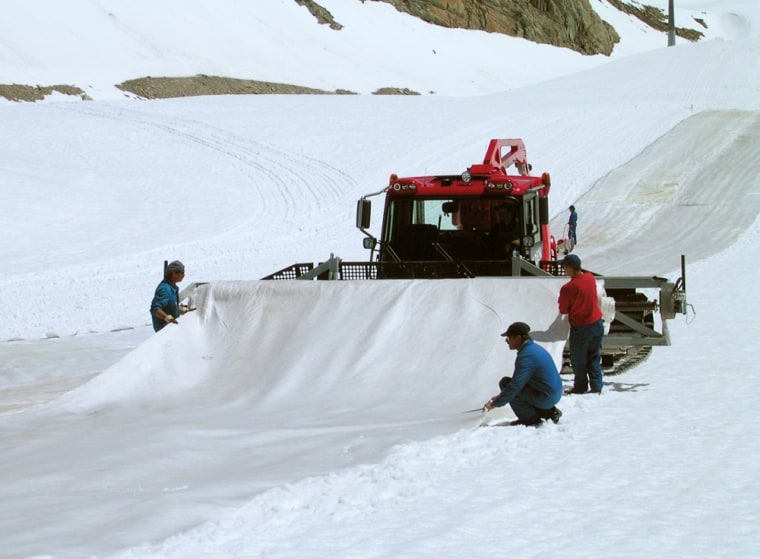INNSBRUCK, Austria — At an altitude of 11,000 feet above sea level the air is thin and the sun rays are intense.
The few skiers and hikers who make their way up to the Stubai glacier in Austria in the early summer are outnumbered by workers covering parts of the ski slopes with tons of white textile — in hopes of protecting the glacier from the glare of the sun.
For years, ski resort operators have been testing different methods to protect the snow along the ski slopes from melting in particularly exposed areas of the glaciers.
Now, with global warming slowly melting glaciers in central Europe, scientists have begun applying a revolutionary method to prevent further glacier melting called "wrapping of the Alpine glaciers.”
Unique research project
There has been a severe glacier retreat over the last two decades, and it has actually increased in the past two to five years. Glacier volumes across the Alps, as well as here in Austria, have been decreasing constantly and the last ice expansion period was recorded in 1980.
The alarming retreat has lead to increased protection efforts, such as extensive slope preparation, injection of water into the snow and the application of fleece covers.
After years of constant struggle, several operators of glacier ski resorts in the greater vicinity of Innsbruck decided to join a unique research project for glacier protection, developed by the university of Innsbruck and Alps, a private institute for natural hazard management.
"The goal of our project is to evaluate and optimize the technical methods with which we can reduce the melting of snow and ice in glacier ski areas," explained Christian Trojer, a project manager at Alps.
White fleece
Within a couple of weeks in June, a white fleece was pulled over snow fields that were especially exposed to sun radiation. The 350 square meter patches were heated along the edges and welded together. Sandbags were used to help to keep the covers in place.
While workers rolled out the approximately 15-foot wide by 210-foot long fleece covers, microbiologists, meteorologists and glacier experts were supporting the two-year research project with scientific testing in the laboratory and on a special glacier test field.
Along with several of her colleagues, Andrea Fischer, the senior researcher in the glacier wrapping project, works at least once a week at an altitude of approximately 8,700 feet, where she shovels snow, measures snow levels and takes snow samples.
"We are also testing about 25 different types of textiles, ranging from hemp and wool to polypropylene materials," Fischer explained.
In order to examine a variety of materials under different climatic circumstances, the scientists also measured parameters like air temperature, wind and humidity.
At the same time, microbiologists evaluated biomass and the chemistry of snow beneath the covers, in order to get a detailed overview of the factors which cause the melting of the glaciers.
"We see two to four meters [six to 12 feet] of ice melt per year, expect to preserve about one meter [approximately three feet] of snow with our geo-textiles, and hope to prevent ice melt in these areas completely," Fischer said.
The white fleece covers come close to the ideal material for snow protection, but the search for the optimum product continues.
"We would like a geo-textile that fully reflects the sun, but, at the same time, is permeable for air and preserves the temperature of the snow adequately," Fischer explained.
Snow equals gold
Tourism — especially when it is linked to skiing — is a huge source of income in Austria. So, maintaining good snow quality and high snow levels is crucial to the economy.
Innsbruck, at the heart of the Austrian Alps, is within striking distance of five ski resorts — including the Stubai glacier ski resort that boasts of year-round skiing, as well as the Pitztal glacier ski resort.
With an annual revenue of $34 million last season, the Stubai glacier ski resort is one of the biggest employers in the region. During peak season, up to 300 people, including local farmers, help to run the "ski circus.”
As many as 1.2 million tourists make their way to the Stubai glacier each year and an estimated 500,000 make it to Pitztal.
Small in terms of big picture
This summer, nearly 25 acres of fleece were applied to the Stubai glacier. That’s a small piece of terrain in comparison to the overall 1,700 acres of slopes which skiers can explore.
"But the results are promising," said Caroline Suitner, the marketing manager at the Stubai glacier. "Within one week with high temperatures, we have already preserved up to 5 inches of snow while it melted in the uncovered parts," she said.
Researchers admit that the project will mainly help the glacier ski resorts to maintain their prepared slopes and give tourists the opportunity to enjoy skiing in more vulnerable glacier areas for a longer period of time, but will not solve broad global warming problems.
"Since only 0.1 per cent of the overall glacier area in Austria is being covered, the application will have no effect that we can measure," said Fischer, the senior researcher in the wrapping project.
But, the project also presents an opportunity to learn more about snow, glaciers and the effects of global climatic change.
"We are not able to save the glaciers," Fischer said. "But I am not too worried because seven to eight thousand years ago we had much less glacier areas in Austria than we have now."
Despite the limited effect, experts still call the new methods revolutionary, comparing them to successes that followed the introduction of artificial snow in the 1980s.
Yet, in the end, it seems to be economic security that counts.
"The snow and the glacier are our gold," says Willi Krüger, marketing director of the Pitztal glacier. "And we need to preserve this gold now, in order to be prepared for the next 20 years."
